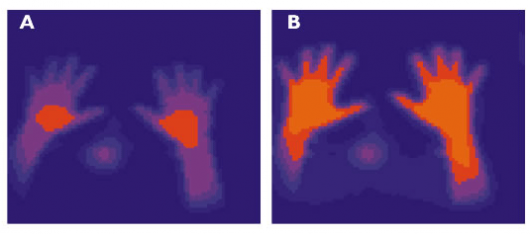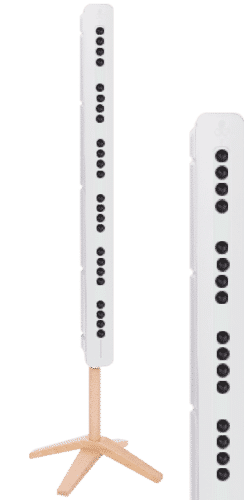ADR-4 – Effet sur la circulation sanguine – Maladie de Raynaud
ADR-4 – Effects on Blood Supply – Raynaud Disease
Typical results of thermographic examination showing improvement in peripheral circulation in a patient with Raynaud’s disease treated with ADR® products.
A – before ADR® products stimulation; B – the same patient after 7 days of using ADR® products.
Thermographic research was conducted at Karol Marcinkowski University of Medical Sciences, Institute of Radiology Radiophysics Department in Poznan, Poland. According to thermographic criteria, a slight decrease of facial temperature, with simultaneous reduction of nose temperature, suggests an increase of internal carotid blood flow (i.e., brain perfusion improvement). The distinct increase in finger temperature (up to 20C) suggests clear blood perfusion improvement.
Thermographic evaluation of the effects of the ADR-4 on blood supply in the hands of persons with generalised blood supply disorders
Authors: Prof. Szczesny Gorski, Phd. Stanislaw Wosinski, Prof. Renata Hause
Summary
A thermographic evaluation of blood supply at rest conditions and of thermoregulatory vasomotor activity was performed on 17 women and 1 man with moderate and serious symmetrical Raynaud’s syndrome in hands and fingers and with moderate and serious symmetrical blood supply disorders at rest conditions in feet and toes, as well as with anamnesis suggesting Raynaud-type vasomotor neurosis. The tests were performed according to our own standard methods. Following initial tests, 7 women and the 1 man applied the ADR-4 energy stimulator, in accordance with the producer’s instructions. 8 women applied an inactive dummy ADR-4. Both groups were chosen at random and the patients did not know whether they were using the active or the inactive form of the appliance. Thermographic evaluation was subsequently repeated in both groups at 1, 3, 7, 14 and 21 days from the commencement of the application of the ADR-4 and the placebo. The following parameters were recorded: maximum and minimum temperatures of fingers and hands on both the palm side and on the back of the hand; the amplitude of the difference between the extreme temperatures in the fingers and mean rate at which the minimum temperature was regained in the fingers of both hands within a period of 10 minutes after standard cooling (expressed as a percentage of the initial temperature). The results showed rises in the values of the thermographic indices being assessed in patients applying the active ADR-4, particularly marked after 14 and 21 days of use. The most clear-cut differences occurred in the minimum temperatures of the fingers and in the chill test. Such effects were not recorded in patients applying the inactive dummy. The results incline one to esteem that the ADR-4 stimulator has a beneficial effect on peripheral blood supply in persons with blood supply disorders.
Key words: thermography, blood supply, women, hands and fingers, magnetic fields, Raynaud’s syndrome, chill test
The use of thermography in the quantitative evaluation of peripheral blood supply has been an indisputable application of this technique for many years. Our own methods for applying thermography, elaborated over many years of practical use, enable this evaluation to be carried out in a standardised, quantified manner, in rest and thermoregulatory vasomotor conditions [i][ii]
Among its applications has been the evaluation of peripheral blood supply in vibration syndrome[iii], the evaluation of blood supply in free skin grafts[iv], in neurological disorders [v] [vi] [vii], in the evaluation of how blood supply in children from sports classes (swimming and athletics) adapted to intensive physical activity[viii].
The present research evaluated changes in blood supply in the hands and fingers under the application of a magnetic energy stimulator invented by one of the authors. The ADR-4 is an energy stimulator registered with the Polish Patents Office under the number P320179. This stimulator consists of a magnetic ceramic disc placed in a special casing. At the base of the disc is a ceramic element, on top of which are placed magnetic elements of various field intensity and specific dimensions, which provide the requisite spatial configuration of a stable, heterogeneous magnetic field. The task of the ADR-4 is to improve the sanitary properties of both pure water and water contained in various aliments. The action of the ADR-4 leads to modifications in the cluster structure of water. We know that in normal conditions water is not an amorphous substance. It forms pseudocrystalline structures, the configuration of which is dependent upon the history of the conditions in which it was located, and it is able to maintain altered properties over a certain time, e.g. surface tension, relative permittivity, electric conductivity, and NMR, NQR, UV and IR spectra (relevant research work is in progress in the Wydzia? Fizyki UAM w Poznaniu [1]). These altered properties in water have a clear influence on living organisms, from bacteria to man. Among the effects produced by the ADR-4 are a change in the fermentation rate of yoghurt (work in progress in the Instytut Rozwoju Mleczarstwa Akademii Rolniczo-Technicznej w Olsztynie [2]), and a change in the aluminium and lead content in hair (work carried out by Trace Elements Inc. in Dallas, USA).
The ADR-4 stimulator was awarded the Gold Medal with special distinction at the 47th World Exhibition of Innovation, Invention and New Technology BRUSSELS EUREKA ‘98.
Materials and Methods
The tests were carried out on 16 persons, aged 20-62 years. They were performed with the help of the AGA 680 Medical thermograph interfaced with a PC, using a program created by Jan B?aszczy?ski, from the firm JBL of Cracow. Our own methods were applied š. The temperature was thermostatically set at a range of 19-21 C. The series of tests covered initial measurements, then repeated measurements at 1, 3, 7, 14 and 21 days from the commencement of the standard application of the ADR-4 stimulator, in accordance with the producer’s instructions.
The subjects were each given, at random, either an active ADR-4 or an inactive dummy, with the same comments concerning the aim of the research, i.e. that it sought to establish whether the application of the device produces any effects. In order to avoid any autosuggestion, the subjects were not informed of the existence of two forms of the appliance – an active and an inactive form.
The tests produced values for the following thermographic parameters: the minimum and maximum temperatures in fingers 2-5, in the whole hand (palm and back), in rest conditions and at 10 minutes after 5 minutes of standard cooling in water at a temperature of 15 C. Prior to their immersion in the cooling bath, the hands were immersed for 5 minutes in water at a temperature of 37 C. The temperature of the water was regulated with a tolerance of 0.1 C. The hands were immersed immediately. After bathing the hands were dried delicately and thoroughly with a paper towel.
Discussion
The results showed no substantial difference in the initial values of the evaluated parameters between the group using the active ADR-4 and the group using the inactive placebo.
The temperatures of the fingers prior to cooling showed a rising tendency both in persons using an active ADR-4 and in persons using the placebo, from the first to the third day. The temperatures then decreased for both groups. From the seventh day onwards, the temperatures then rose in the ADR-4 group, but not in the placebo group. These temperatures express blood supply in rest conditions. After cooling, the temperatures behaved in a similar manner in the test group, whereas in the control group the initial rise was absent. These temperatures reflect the intensity of the thermoregulatory vasomotor reaction. This may indicate the existence of a two-phase thermoregulatory reaction under the stimulus of the ADR-4. The first phase can be linked to the placebo effect, since it also occurred in the persons using the dummy. Similar rises, albeit considerably less marked, were observed over the area of the whole hand.
Conclusions
The tests carried out allow the following inferences to be drawn.
The entire range of temperatures in the fingers and hands, as well as the rate at which the minimum temperature in the fingers was regained after cooling, in persons with moderate and serious, symmetrical, generalised blood supply disorders, with many years of anamnesis, showed a favourable change from the seventh day of the use of the ADR-4 stimulator.
Analogous changes were not observed in those persons with similar blood supply disorders who used the inactive dummy.
The rises in the thermographic indices were most marked in the fingers, and the least significant over the whole hand.
The rises in the indices were more substantial in the test after cooling than in the test without cooling.
The results incline one to acknowledge the presence of a beneficial effect from the use of the ADR-4 stimulator on peripheral blood supply.
References
Sz. Gorski, W. Fibiger: Thermographic Functional Test in the Diagnosis of Vascular Disorders in Vibration Syndrome. Medycyna Pracy 1979, XXX, 3, pp.213-220.
Sz. Gorski, J. Blaszczynski, B. Wiecek: Integrated Thermographic and Visual System for the Computer Assisted Diagnosis of Peripheral Blood Supply Disorders and Inflammatory Processes. KBN 8T11E 040 10.
Sz. Gorski: Aspects thermographiques des micro et macro -traumatismes de la main. II Congres Europeen de la Thermographie, Barcelona, 11-15.09.1978. Abstract Book, Heralds de Aragon, Zaragoza, 1978, p.154.
H. Paszkowska, Sz.Gorski: Evaluation of the Healing of Autogenic Free Full Skin Grafts. Thermographic and Histochemic
J. Koczocik-Przedpelska, Sz. Gorski, E.Powierza: Relationship between sensory nerve conduction and temperature of the hand. Acta Physiol.Pol.,1983, Vol. 43, fasc.1, pp.21-28.
J. Koczocik-Przedpelska, Sz. Gorski: Double Pattern of Relationship between Skin Temperature, Thermoregulation and Sensory Nerve Conduction. Electromyography and Clinical Neurophysiology, 1990, 30, pp. 435-442.
Sz. Gorski, E.Rostkowska: The Benefits of the Application of Thermovision in Sports Science Research. Series: Monografie Nr 288, 1991 Wydawnictwo AWF w Poznaniu 1991, pp. 19-23.

